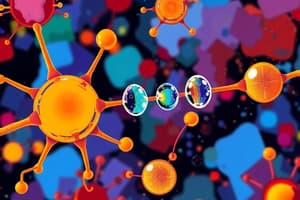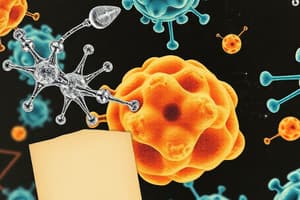Podcast
Questions and Answers
What is indicated by a drug having a high affinity for its receptor?
What is indicated by a drug having a high affinity for its receptor?
- It is effective at low concentrations. (correct)
- It binds weakly to the receptor.
- It requires a larger dose to be effective.
- It has no effect at high concentrations.
What is the likely consequence of a drug binding weakly to its receptor?
What is the likely consequence of a drug binding weakly to its receptor?
- It will activate the receptor immediately upon binding.
- It binds easily to multiple receptor types.
- A much higher dose may be required for effectiveness. (correct)
- It works best at low concentrations.
What characterizes the binding pocket of the estrogen receptor?
What characterizes the binding pocket of the estrogen receptor?
- It features hydrophobic residues and has a narrow binding pocket. (correct)
- It is shaped to fit only hydrophilic molecules.
- It is large and accommodates multiple types of ligands.
- It consists primarily of charged residues for ionic bonding.
What does an L1/2 of ~1nM for estradiol suggest about its binding properties?
What does an L1/2 of ~1nM for estradiol suggest about its binding properties?
Which of the following best describes the relationship between drug concentration and binding affinity?
Which of the following best describes the relationship between drug concentration and binding affinity?
What defines the binding cooperativity of hemoglobin?
What defines the binding cooperativity of hemoglobin?
How is the concentration of ligand related to receptor binding?
How is the concentration of ligand related to receptor binding?
What is indicated by L1/2 in receptor-ligand interactions?
What is indicated by L1/2 in receptor-ligand interactions?
What can be inferred about a drug that binds tightly to its target receptor?
What can be inferred about a drug that binds tightly to its target receptor?
Which of the following describes molecular recognition?
Which of the following describes molecular recognition?
What is the effect of drug binding on therapeutic outcomes?
What is the effect of drug binding on therapeutic outcomes?
How do proteins influence molecular recognition?
How do proteins influence molecular recognition?
What does a steeper slope in a ligand binding graph indicate?
What does a steeper slope in a ligand binding graph indicate?
What role do nucleic acids play in drug action?
What role do nucleic acids play in drug action?
What happens when both the ligand and receptor concentrations are increased?
What happens when both the ligand and receptor concentrations are increased?
Flashcards are hidden until you start studying
Study Notes
Learning Outcomes
- Understanding drug interactions as molecular-based phenomena.
- Recognizing the role of ligand concentration in receptor binding dynamics.
- Exploring the binding principles of oxygen by myoglobin and hemoglobin.
- Examining binding cooperativity in hemoglobin for effective oxygen transport.
- Understanding that therapeutic drug effects stem from binding to biological macromolecules.
Molecular Recognition
- Molecular recognition refers to the specific binding interactions between molecules, essential in biochemical processes.
- Binding complexes exhibit distinct three-dimensional structures, defined by secondary, tertiary, and quaternary arrangements.
Receptors and Ligands
- A receptor (R) is typically a protein that binds to a ligand (L) to form a complex (RL).
- The equilibrium expressed as [R] + [L] ⇌ RL emphasizes that binding is concentration-dependent.
- Binding affinity is determined by measuring the proportion of bound RL at varying ligand concentrations.
Binding Characterization
- L1/2 indicates the concentration of ligand required to saturate half of the receptors.
- A lower L1/2 signifies a more potent ligand, indicating stronger receptor binding.
- Drug effectiveness is correlated with binding strength; tight interactions require lower doses for therapeutic effect.
Affinity and Dosage
- Strong receptor affinity allows drugs to be effective at lower concentrations (exemplified by a black line on binding graphs).
- Weak receptor affinity necessitates higher concentrations, leading to higher dosage requirements for efficacy.
Protein Binding Pockets
- Proteins possess specific binding pockets that match the shapes of their ligands.
- Estrogens, a class of steroid hormones, play critical roles in female reproductive development.
- The estrogen receptor features a narrow, hydrophobic binding pocket that accommodates estrogen ligands.
Estrogen Receptor Specificity
- The estrogen receptor selectively binds estrogens, facilitating signaling.
- Estradiol binds to estrogen receptors with an impressive L1/2 of approximately 1 nM (10^-9 M), reflecting high potency.
Studying That Suits You
Use AI to generate personalized quizzes and flashcards to suit your learning preferences.




